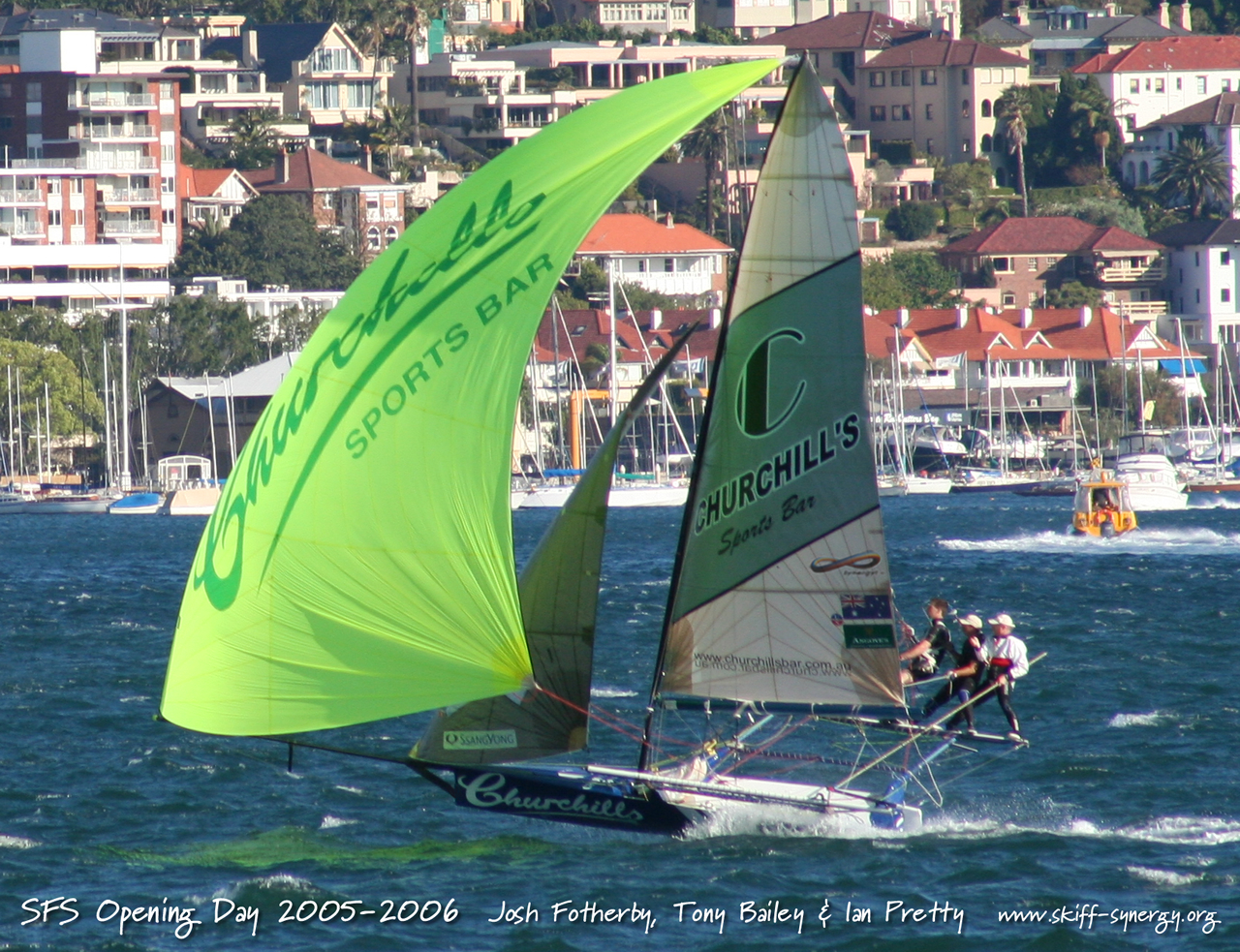- 18ft Skiff
Infobox Sailboat Specifications

caption = International 18' Skiff "Churchills" on Sydney Harbour
class_symbol =
numberofcrew = 3 (Triple Trapeze)
loa = 8.9 m (29.2 ft)
lwl = 5.49 m (18 ft)
beam = 2.0 m (6.56 ft)
draft =
hull = 155 kg (335 lbs)
mainsailandjib= Unlimited, typically 26 to 32 msu|p=2
mastheight =
mainsail = 9.28 msu|p=2 (100 ftsu|p=2)
jib =
spinnaker = Unlimited, typically 61 to 73 msu|p=2
dpn =
phrf =
portsmouth =
updated =
olympic =
formerolympic = The 18ft Skiff is considered the fastest class of sailing skiffs. The class has a long history beginning with races onSydney Harbour ,Australia in1892 . The boat has changed significantly since the early days, bringing in new technology as it became available. Because of the need of strength, agility and skill, the class is considered to be the top level of small boat sailing. Often this boat is called the "Aussie 18" due to its inherent connections to Australia. They are the third fastest dinghy on the yardstick rating, and are placed higher than boats like nacras and hobies. This extremely fast boat is hard to sail, but is very agile and fun once mastered.History
The 18ft Skiff has come a long way in more than 100 years of continuous development. From heavy boats carrying a crew of ten or more, to today's high-tech, light-weight, high performance design. Parts of the history of the early days of skiff sailing, between 1892 and 1945, is found on the [http://www.18footers.com.au/index.php/australian-18-footers-league-2007-2008-racing-season/history pages of the Australian 18 Footers League] .
The modern 18 ft Skiff
Today there are two modern hull designs racing. The "International 18" is based on a design by Iain Murray, while the B18 was designed by
Julian Bethwaite . TheAustralian 18 Footer League allows only one design racing, using the International 18, while the European Class Association allows both designs to compete against each other.Although there are differences in the sailing aspects of the two designs, their measurements are very close, with a waterline length of 18 ft (5.49 m) and an average beam of 6 to 8 feet (1.83 to 2.44 m), not including the wings. With wings the maximum beam is 14 feet for the "International 18" and 18 feet for Open 18's sailed at Sydney Flying Squadron. When the
boat is dry it should weigh not less than 375 lb (170 Kg) including wings, foils (centreboard andrudder ) and the number one rig ofsail s,spar s andrope s.In the 1980's and 90's wings were widened to the extreme - some boats having maximum beam of 26 feet. Such wings proved unmanageable, with the crews too much on the brink of disaster for consistent success.
While true 18' skiffs have no sail area or mast height limitations, the limit that the 18 footer League has specified for their one-design sub class is a maximum mast height of 33 ft (10 m), truly powerful on an 18' hull. The entire rig, which supports sails with unlimited area, is controlled by three trapezing
crew members.The boat will plane upwind starting at a true windspeed of about 8 knots, and off the wind can reach speeds of double the true windspeed. This is possible through the very high sail-carrying power to total weight ratio, which is above 30% with the no. 1 rig and approaches 40% with the no. 3 rig (for reference, a 30% ratio is needed to plane upwind and a 10% ratio is needed to plane at all. Most cruising boats have a ratio under 5%).
Future evolutions of skiffs may incorporate hydrofoils, such as Synergy! skippered by Michael Carter above.
In Australia, there is a fleet of approximately 20-25 18 Foot Skiffs at the "League" club in Sydney. Sydney's other traditional 18 Foot Skiff club, the Sydney Flying Squadron, has a small fleet and there are several boats in the state of Queensland.
However, the 18 ft skiff is not without is dangers. The high speed makes it hard to handle and requires extremely fast reflexes and a broad awareness of your surroundings in order to anticipate changes. Major accidents can occur with inexperienced and experienced sailors alike.
The 18 ft skiff is currently one of the fastest monohulls on earth. With its massive
sail-plan of over 100 square meters on the no. 1 rig and three crew members on trapeze it can outperform nearly every monohull on the water. It combines extreme speeds with an element of danger and is thought by many to be one of the biggest spectacles insailing .Current JJ Giltinan International champions: Gotta Love It 7- Seve Jarvin, Sam Newton and Robert Bell
The Historical 18’ Skiff
In
Sydney andBrisbane Australia there has been a revival of the early days of 18’ skiff sailing. Replicas of famous 18’ skiffs from the period of1930 through to1950 have been built using original techniques, including wooden hulls andspar s,gaff rig s, several-piecespinnaker pole s and unrestrictedsail area. These boats race under the rules of theAustralian Historical Skiff Association , which bans wings, trapezes, cleats for controlling ropes for themainsail ,jib andspinnaker , and most of the other modern equipment which makes sailing easier.The class has proved very popular with former sailors of modern 18’ skiffs who, to quote a class champion
John Winning , are looking for a challenge because “the modern boats have become too easy to sail”.The historical 18’ skiffs have a crew of between 6 and 9, which often leaves an opportunity for visiting sailors to have a ride.
At present the class is raced out of the Sydney Flying Squadron in Sydney and the Brisbane 18 Footers Sailing Club Inc. There are also bi-annual challenges against the New Zealand 18’ Kauri-Clinker M Class.
ee also
*
12ft Skiff External links
* [http://www.sydneyflyingsquadron.com.au/ Sydney Flying Squadron]
* [http://www.18footers.com.au Australian 18 Footer League]
* [http://www.18footer.org European 18 Foot Skiff Class Association]
* [http://www.uk18footer.org UK 18 Foot Skiff Class Association]
* [http://18footer.abeachsomewhere.net]
* [http://brisbane18s.asn.au]
Wikimedia Foundation. 2010.
